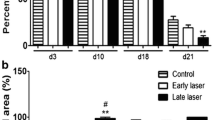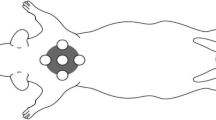Abstract
Third-degree burn wounds are considered severe injuries because they destroy all the skin layers and may affect subcutaneous tissues, fasciae, muscles, and bones. To favor the healing process of the injured tissues, it is very useful to diminish the occurrence of the inflammatory process. The present study was aimed at comparing the effect of different energetic densities of AlGaInP laser on the inflammatory process and in the healing of third-degree burn wounds in Wistar rats. This study was approved by the Ethics Committee, in which 36 adult male rats were selected and suffered the induction of third-degree burn injury. These rats were divided as follows: group 1—control (treated with silver sulfadiazine), group 2—received energy density of 3 J/cm2, and group 3—received energy density of 6 J/cm2. All animals daily received an occlusive bandage with silver sulfadiazine and 8 % papain. The laser therapy was performed alternatively three times a week. The animals were evaluated on the 3rd, 7th, 14th, and 21st days after the initial lesion and euthanized for the macroscopic, histologic, and morphometric analysis. A higher production of collagen was observed at 7 days and a greater re-epithelialization at 21 days in group 3 (6 J/cm2). Furthermore, the latter when compared to the other groups presented macroscopically a better aspect of the scar at 21 days with more granulation tissue and fibrosis. We conclude that the AlGaInP laser used in dosages of 3 and 6 J/cm2 favors the healing of third-degree burn wounds induced in rats.





Similar content being viewed by others
References
Vale ECS (2005) Primeiro atendimento em queimaduras: a abordagem do dermatologista. An Bras Dermatol 80:9–19
Lima Júnior EM, Novaes FN, Piccolo NS, Serra MC (2008) Tratado de queimaduras no paciente agudo, 2nd edn. Atheneu, São Paulo
Montes SF, Barbosa MH, Sousa Neto AL (2011) Aspectos clínicos e epidemiológicos de pacientes queimados internados em um Hospital de Ensino. Rev Esc Enferm USP 45:369–373
Vendrusculo TM, Balieiro CRB, Echevarría-Guanilo ME, Farina Junior JA, Rossi LA (2010) Queimaduras em ambiente doméstico: características e circunstâncias do acidente. Rev Lat Am Enfermagem 18:444–451
Blanes L (2011) Tratamento de feridas. Cirurgia vascular: guia ilustrado. São Paulo [on line]. http://www.bapbaptista.com. Accessed 01 Nov 2011
Fernandes LRA (2005) Fisiologia da cicatrização–feridas e curativos. [on line]. http://www.unimes.br/aulas/MEDICINA/Aulas2005/1ano/Procedimentos_basicos_em_medicina/feridas_e_curativos.html. Accessed 01 Nov 2010
Azevedo AMZ, Machado MJ, Chassot GC (2002) Assistência de enfermagem nos pacientes queimados com curativo aberto na unidade de internação. Mom Perspec Saúde 15:1–7
Santucci SG, Gobara S, Santos CR, Fontana C, Levin AS (2003) Infections in a burn intensive care unit: experience of 7 years. J Hosp Infect 53:6–13
Bourguignon-Filho AM, Feitosa ACR, Beltrão GC, Pagnoncelli RM (2005) Utilização do laser de baixa intensidade no processo de cicatrização tecidual. Rev Port Estomatol Cir Maxilofac 46:37–43
Veçoso MC (1993) Laser em fisioterapia. Lovise, São Paulo
Bayat M, Vasheghani M, Razavi N (2008) Effects of low-level laser therapy on mast cell number and degranulation in third-degree burns of rats. JRRD 45:931–938
Pereira RM (2005) Efeitos dos lasers de baixa potência em três diferentes comprimentos de onda no processo de cicatrização de queimaduras de 3° grau. Thesis. Universidade Vale do Paraíba
Schlager K, Oehler K, Huebner M, Schmuth L, Spoetl L (2000) Healing of burns after treatment with 670-nanometer low-power laser light. J Dermatol Surg Austria 105:1635–1639
Santuzzi CH, Buss HF, Pedrosa DF, Freire MOV, Nogueira BV, Goncalves WLS (2011) Uso combinado da laserterapia de baixa potência e da inibição da ciclooxigenase-2 na reepitelização de ferida incisional em pele de camundongos: um estudo pré-clínico. An Bras Dermatol 86:278–283
Júnior AMR, Oliveira RG, Farias RE, Andrade LCF, Aarestrup FM (2006) Modulação da proliferação fibroblástica e da resposta inflamatória pela terapia a laser de baixa intensidade no processo de reparo tecidual. An Bras Dermatol 81:150–156
Reddy GK (2004) Photobiological basis and clinical role of low-intensity lasers in biology and medicine. J Clin Laser Med Surg 22:141–150
Posten W, Wrone DA, Dover JS, Arndt KA, Silapunt S, Alam M (2005) Low-level laser therapy for wound healing: mechanism and efficacy. Dermatol Surg 31:334–340
Maiya GA, Kumar P, Rao L (2005) Effects of low intensity helium-neon (He-Ne) laser irradiation on diabetic wound healing dynamics. Photomed Laser Surg 3:187–190
Guirro ECO, Guirro RRJ (2004) Fisioterapia dermato funcional: fundamentos, recursos, patologias, 3rd edn. Manole, São Paulo
Lange F, Kroth A, Steffani JA, Lorencetti N (2003) Influência da laserterapia no processo cicatricial de queimaduras de terceiro grau. Fisioter Bras 4:335–340
Gomes DR, Serra MC, Pellon MA (1995) Queimaduras. Revinter Ltda, Rio de Janeiro
Mello PB, Sampedro RMF, Piccinini AM (2007) Efeitos do laser HeNe e do modo de aplicação no processo de cicatrização de queimaduras em ratos. Fisioterapia Pesquisa 14:6–13
Low J, Reed A (2001) Eletroterapia explicada princípios e prática. Manole, São Paulo
Oliveira PC, Meireles GCS, Santos NR, Carvalho CM, Souza APC, Santos JN, Pinheiro ALB (2008) The use of light photobiomodulation on the treatment of second-degree burns: a histological study of a rodent model. Photomed Laser Surg 26:289–299
Meirelles GCS (2005) Análise comparativa do efeito dos lasers GaAlAs de 660 nm e 780 nm na cicatrização de úlceras por queimadura em dorso de ratos diabéticos e não-diabéticos: estudo histológico. Thesis. Universidade Federal da Bahia
Gál P, Vidinsky’ B, Toporcer T, Mokrý M, Mozes S, Longauer F, Sabo J (2006) Histological assessment of the effect of laser irradiation on skin wound healing in rats. Photomed Laser Surg 24:480–488
Acknowledgments
The authors would like to thank Sharon Lois Vinaud for the English review. The authors would also like to thank the Burning Wounds Hospital of Goiania (Hospital de Queimaduras de Goiania) and Eduardo Di Oliveira Pires from the Núcleo Integrado de Reabilitação e Educação for providing the AlGaInP laser for this study, and Dr. Nelson Sarto Piccolo from the Nelson Piccolo Institute and Farmácia Artesanal for providing the papain.
Author information
Authors and Affiliations
Corresponding author
Rights and permissions
About this article
Cite this article
de Moraes, J.M., Eterno de Oliveira Mendonça, D., Moura, V.B.L. et al. Anti-inflammatory effect of low-intensity laser on the healing of third-degree burn wounds in rats. Lasers Med Sci 28, 1169–1176 (2013). https://doi.org/10.1007/s10103-012-1213-1
Received:
Accepted:
Published:
Issue Date:
DOI: https://doi.org/10.1007/s10103-012-1213-1




